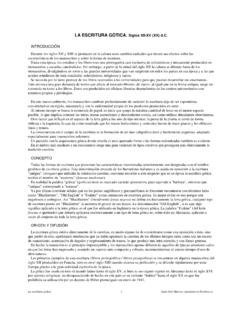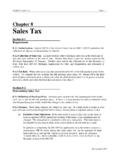Transcription of Latin Paleography (Fonts for Latin script)
1 FONTS FOR Latin Paleography . Capitalis elegans, capitalis rustica, uncialis, semiuncialis, antiqua cursiva romana, merovingia, insularis majuscula, insularis minuscula, visigothica, beneventana, carolina minuscula, gothica rotunda, gothica textura prescissa, gothica textura quadrata, gothica cursiva, gothica bastarda, humanistica. User's manual 5th edition 2 January 2017. Juan-Jos Marcos Professor of Classics. Plasencia. (C ceres). Spain. Designer of fonts for ancient scripts and linguistics ALPHABETUM Unicode font PALEOGRAPHIC fonts TABLE OF CONTENTS. chapter Page Table of contents 2. Introduction 3. Epigraphy and Paleography 3. The Roman majuscule book-hand 4. Square Capitals (capitalis elegans) 5. Rustic Capitals (capitalis rustica) 8. Uncial script (uncialis) 10. Old Roman cursive (antiqua cursiva romana) 13. New Roman cursive (nova cursiva romana) 16. Half-uncial or Semi-uncial (semiuncialis) 19.
2 Post-Roman scripts or national hands 22. Germanic script (scriptura germanica) 23. Merovingian minuscule (merovingia, luxoviensis minuscula) 24. Visigothic minuscule (visigothica) 27. Lombardic and Beneventan scripts (beneventana) 30. Insular scripts 33. Insular Half-uncial or Insular majuscule (insularis majuscula) 33. Insular minuscule or pointed hand (insularis minuscula) 38. Caroline minuscule (carolingia minuscula) 45. Gothic script (gothica prescissa, quadrata, rotunda, cursiva, bastarda) 51. Humanist writing (humanistica antiqua) 77. Epilogue 80. Bibliography and resources in the internet 81. Price of the paleographic set of fonts 82. Paleographic fonts for Latin script 2 Juan-Jos Marcos: INTRODUCTION. The following pages will give you short descriptions and visual examples of Latin lettering which can be imitated through my package of "Paleographic fonts", closely based on historical models, and specifically designed to reproduce digitally the main Latin handwritings used from the 3rd to the 15th century.
3 These typefaces closely follow the original scripts. Naturally it is beyond my scope to write a treatise on Paleography ; this humble article only proposes to provide a simple quick visual reference to Latin handwriting, allowing a glance specifically at book-hands, typically used during the Roman Empire and Middle Ages. Please also note that none of the following examples given in the following pages have been chosen for their special beauty, but merely as examples of particular hands. EPIGRAPHY AND Paleography . Epigraphy is the study of written matter recorded on hard or durable material, whereas Paleography is the study, interpretation and analysis of the handwriting in ancient documents ( on soft material). Fonts I have designed belong to the paleographical category. CONCEPT OF Paleography . Paleography is the study of ancient methods of writing, most properly writing on parchment or paper or equivalent material, such as wooden tablets, leaves, canvas, or any other material on which one can write with a pen, reed, or paintbrush.
4 Paleography investigates the history of the characters used to represent speech, traces the changes from age to age in those of the same language, teaches the art or science of deciphering documents, and determines their date and place of origin from the style of writing. Paleography is the art of analysing and reading handwriting. Some would call it a science, and to a degree it has acquired a veneer of scientific style, classification and ordering, but ultimately it evolves one human individual attempting to understand the unique efforts at communication of another. Paleography is fundamentally an art, with some scientific props. In fact, Paleography was not recognized as a science until the publication in 1681 of the De Re Diplomatica of Jean Mabillon (1632-1707), who gave directions in this work for distinguishing, by the writing itself, between the genuine documents of the Middle Ages and the forgeries that were current in his time.
5 The terminology of Paleography was used for the first time in 1703 by Bernard de Mountfaucon, a Benedictine monk, when he published a book entitled Paleographia Graeca, sive de ortu et progressu litterarum. Etymologically, this word is composed of two Greek terms (ancient), and (written). Consequently we translate: science that studies ancient writings . SCOPE OF THE Paleography . By the definition given above Paleography should include the study of writings of every sort, of all times and all peoples, regardless of the material which received them. As a branch of classical philology, however, its scope has been greatly restricted. In the first place it is limited to the Greek and Latin languages, and in the second place Epigraphy and Diplomatics, once mere branches of Paleography , have won for themselves the rank of independent sciences. The former treats of the very oldest written records of Greece and Rome, those, that is, cut in stone and metal, or scratched and painted upon wood or other hard substances; the latter deals with the charters, wills, deeds, grants, etc.
6 , of the centuries following the breaking up of the Roman empire. Several related disciplines are distinguished from Paleography based on the material on which the writing is found. Papyrology, the study of writing on papyrus, requires special skills, but is essentially a branch of Paleography (at least so far as it is occupied with reading papyri, and identifying their dates, provenance, place and style of writing, and other facts about the circumstances of copying and transmission; so far as the papyrologist is concerned with editing papyri, he practices textual criticism; so far as he uses the papyri for historical analysis, he is a historian). Paleographic fonts for Latin script 3 Juan-Jos Marcos: The study of writing stamped on coins belongs to the separate discipline of Numismatics. Inscriptions on stone, metal, pottery, gems, seal-stones, stamps, weights, lamps, and other household items belong to Epigraphy.
7 Although regarded as a separate discipline, Epigraphy is of importance to the paleographer, since the earliest examples of writing are usually found in inscriptions, and since there continues to be a mutual influence of inscriptions and other forms of writing on each other. To Paleography is left, therefore, merely the study of the writing, or various styles of writing, found in the manuscripts of the works of literature that have descended to us. Limiting our study of Paleography to Latin manuscripts as we do, the period covered extends from the third or fourth century A. D., the time when the oldest codices now existing were written, to the fifteenth century, when the scribe was succeeded by the printer. Latin Paleography . We now proceed to trace the history of the Latin Paleography , and the scheme which will be followed in this division of our subject may first be briefly stated. Latin Majuscule writing, in its two branches of Square Capitals and Rustic Capitals, and Uncials the most ancient extant forms of the Latin book-hand claims our first attention.
8 Next, the mixed hands of uncial and minuscule letters, known as Half-uncial writing, will be examined. We shall then have to pass in review the various styles of Roman Cursive writing, beginning with its earliest examples; and from this we shall proceed to follow the course of the National Minuscule hands (Gernanic, Merovingian, Visigothic and Beneventan), which were derived directly from that source. The independent history of the early Irish and English (Insular) handwriting forms a chapter apart. From the period of Charlemagne to the end of the fifteenth century, the vicissitudes of the literary handwritings of Western Europe (Caroline minuscule, Gothic hands and Humanistic scripts) will be described as well. In the following chapters we will have a close look at the different handwriting styles used in Latin manuscripts. THE ROMAN MAJUSCULE BOOK-HAND. The Latin Majuscule book-hand of early manuscripts is divided into two branches: writing in Capitals, and writing in Uncials.
9 Capitals, in turn, are of two kinds: Square Capitals and Rustic Capitals. The most ancient Latin manuscript in existence (De bello Actiaco, fragments of a poem on the battle of Actium found in Herculaneum, see image below) is in Rustic Capitals; but there is no reason to presume that the rustic hand was employed in manuscripts before the square hand, rather, following the analogy of sculptured inscriptions, the priority should be given to square letters. Rustic Capitals: "De bello Actiaco", written between 31 and 79. Paleographic fonts for Latin script 4 Juan-Jos Marcos: The earliest Roman script, to judge from inscriptions, was entirely in capitals. The most formal variety of them was a majuscule (or capital) script which we now term Square Capitals (capitalis quadrata), used mainly for carved inscriptions, where it is also known as scriptura monumentalis. Square Capitals: Monumental letters carved in stone, which will be adapted for high-status manuscript pages.
10 Here is an image of the inscription on Trajan's Column, 114. Notice the gradation in size from the bottom up. This is so that the letters all appear to be the same height when viewed from below. The epigraphical capital of our printed books was adapted as a book-hand for use in manuscripts, but there exist only rare specimens of it. This beautiful script seems to have been exclusively reserved for de luxe manuscripts and for the most revered works, such as Virgil or the Bible. Since Square Capitals were very laborious to write because of its straight lines and angular forms, they were more suited for carving inscriptions on stone with a chisel than for a text on papyrus or parchment with a pen. Hence, for more general purposes, a less formal, quicker written variation was needed. Romans developed a new book-hand called Rustic Capitals (capitalis rustica) to meet these needs. Rustic Capitals were a majuscule script with rather more rounded letter forms that were easier to produce with a reed pen (calamus) or a quill (penna) than the angular forms of Square Capitals.





![[El racionalismo de Descartes] - guindo.pntic.mec.es](/cache/preview/6/6/2/8/e/3/a/c/thumb-6628e3ac4086812db3ea27df3267735b.jpg)






